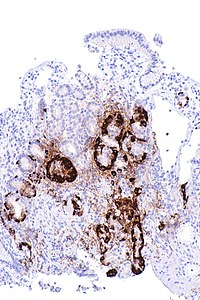Pernicious Anemia

In the relatives of 34 pernicious anemia probands, McIntyre et al. (1959) tested the ability to absorb orally given doses of cobalt-60 labeled vitamin B12 (Schilling test). The relatives of pernicious anemia patients showed a negative correlation with age; control subjects did not. The relatives showed a tendency to bimodality. Forty-eight percent of sibs and 32% of offspring had abnormal absorption. The authors suggested autosomal dominant inheritance. Wangel et al. (1968) suggested that the tendency to form autoantibodies against gastric parietal cells may be inherited as a dominant with incomplete penetrance. Later studies (McIntyre, 1968) yielded results that make a simple genetic hypothesis difficult to support. As pointed out by Twomey (1975), pernicious anemia shows a 10-fold increase in patients with multiple myeloma and a 250-fold increase in adults with immunoglobulin deficiency.